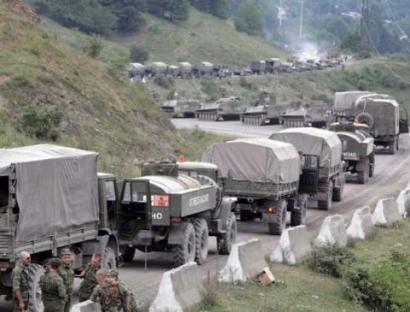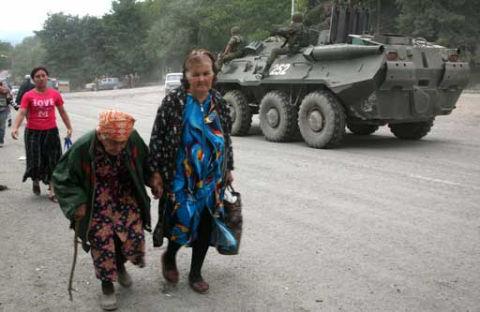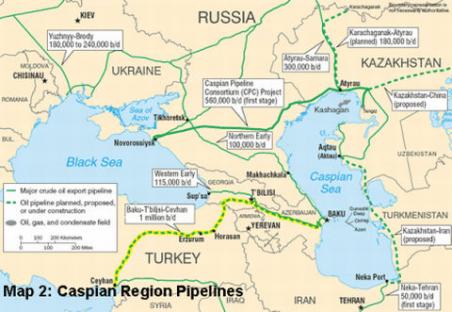You are here
Home ›War in Georgia: Who Will Control the Oil and Gas of the Caspian Basin?
This was the first statement issued by the Bureau at the start of the war and has been translated into several languages as has the article on South Ossetia which follows.
Probably the words which best describe the present situation in the southern Caucasus - as well as the divergent standpoints of the opponents - are those attributed to a private conversation between Putin and Bush at the opening ceremony of the Beijing Olympics. The Russian premier is supposed to have said in no uncertain terms that “in fact war has broken out in South Ossetia”, adding, however, that the intervention will only be for limited aims, but also that “in Russia many volunteers intend to go there and it is undoubtedly very difficult to maintain peace in the region”. Bush seems to have limited himself to replying that “nobody wants a war”.
The events which led up to the outbreak of the conflict on the night between 7th and 8th August are not clear. In any case the escalation - heralded by a series of mutual provocations, and also by the evacuation of women and children from South Ossetia which was already underway at the beginning of July - was alarming right from the outset. Throughout the next day Russian and Georgian forces were still fighting for control of Tskhinvali, the capital of the separatist area. Meanwhile Russian planes had bombarded the city of Gori and various other targets in Georgian territory, destroying the port of Poti which lies next door to the Supsa oil terminal. Planes could be seen coming from Armenia and the conflict was soon extended to Abkhazia, another separatist region, from where an offensive against the Georgian troops waiting in the Kodori Gorge could be launched. It is even more difficult to quantify the civilian victims. Russian sources describe a massacre involving 1,500 dead, including civilians, but the figure is contested by Tbilisi. What is certain is that none of the attacks, whether or not in Ossetian or Georgian territory, have spared the local population.
On his part the Georgian president, Saakashvili, has explicitly called for US intervention:
This is no longer a Georgian question. It is a matter of America and its values. We are a freedom-loving nation which now finds itself under attack.
For the moment we will ignore the presumed “democratic” nature of the reactionary Saakashvili regime, based, like its American sponsors, on nepotism and repression of any opposition. However, it is obvious that the events in Ossetia, apart from sparking an immediate conflict between Russia and Georgia, are also at the centre of a struggle between Russia and the USA over NATO interference in the ex-Soviet zone and for control over the development of trade and transport routes for Caspian oil and gas which are the real “values” at stake.
Furthermore this is further proof - if proof were needed - that in the epoch of imperialism every national question ends up being absorbed by the wider process of imperialist reconstitution which is currently underway. It could not be otherwise for South Ossetia.
Thus this conflict has not come like a bolt from the blue but has been in preparation for years. Ever since the collapse of the Soviet Union in 1991 relations between Russia and Georgia have never been close, but they significantly worsened after the “Rose Revolution” of 2003 - part of the series of so-called colour revolutions financed by US money - substituted the weak and corrupt government of Shevarnadze with that of the ultra-nationalist Saakashvili. By the end of 2006 the “spy crisis” was an indication of the build-up of tension. As we wrote on that occasion:
Behind all the tensions in the Caucasus there hides a struggle which knows no bounds for control of energy flows. Until now the only possible route for the oil from both Baku and Tengiz has been the CPC pipeline (Caspian Pipeline Consortium) which guaranteed Russia almost complete control of the area’s resousrces. But after the opening of the Baku-Tbilisi-Ceyhan (BTC) oil pipeline on 13th July oil will flow without crossing Russian borders. A parallel gas route - the South Caucasus Gas Pipeline (SCP), is in the process of being completed. (1)
Since then however several significant changes have taken place. Tensions have arisen over the anti-missile shield with radar and missile launch pads which the USA wants to put in Eastern Europe especially Poland and the Czech Republic. Additionally the deployment of US bases and troops whose presence in the Caucasus and Central Asia has always been problematic continues to irritate Russian imperialism which sees these areas as its “backyard”. If we had to identify a precise event when Moscow’s patience probably ran out it was last spring when the agreements on energy imports from Central Asia (Turkmenistan, Uzbekistan and Kazakhstan) were all finalised with big increases in losses for Gazprom (it seems that the agreed price for 2009 is near $250 per 1000 cubic metres of gas). The Central Asian states were able to negotiate on different terms from the past achieving satisfactory prices by threatening to take the trade elsewhere. Here the trans-Caucasian pipelines play a central role.
But the framework was, and is already changing. In the first place the international financial crisis, starting with the so-called “sub-prime crisis” in the USA is redefining inter-imperialist competition. According to statement by the Russian Minister of Foreign Affairs,
The USA is on the brink of a crisis of survival, a mass crisis... The United States is on the slide towards drastic and dire changes unless it begins to learn to live within its means
and he then predicted only “a lesser interdependence” in Russia’s relations with the USA, or rather, greater independence not only from the devalued US currency, but also from its political and military agenda.
In fact a wider crisis of US imperialism, inextricably linked to the financial crisis is developing. Not only is it mired in Afghanistan and Iraq but it even failed this year in its aim tog et Georgia and the Ukraine into NATO. This would have brought the Atlantic Alliance to the borders of Russia. Instead the NATO Summit in Bucharest last April, under pressure from the Russian “niet” and due to French and German opposition shut the door on the entry of ex-Soviet states into the Alliance. This false move by the US alerted the Russian government to the extent of the weakness of US imperialism. It now signalled its intention of taking the lead on the international stage.
In fact Russia itself is not immune to the crisis of the accumulation cycle. Nevertheless it glimpses the possibility of diverting the crisis (or at least its effects) abroad by seeking to impose the domination of the rouble over the dollar and controlling energy prices and therefore to a certain degree the organic composition of competing capitals.
Russia thus means to re-establish itself at the centre of the imperialist world order, both on the terrain of raw materials for energy (it is already the world’s greatest exporter of oil and gas combined) and financially. This is how Putin’s Law of May 2006 should be seen. This forced Russian operators to sell gold and oil in roubles putting it in direct competition with the dollar. The geopolitical magazine, Limes (“Project Russia”), reports that inside the Kremlin the aim is to pursue the formation of a “Russian Union”. Though echoing the Soviet Union in name, the plan nevertheless does not mean an ahistorical return to the old empire. The new project may be even more ambitious based on the “geo-politics of gas” or rather the semi-monopolistic control of energy resources, their means of transit and above all the revenues and speculation linked to this trade. This would extend Russia’ influence well beyond the old Soviet borders.
The different imperialist powers, ruthlessly pursuing the course of the concentration and centralisation of capital are each aiming to tip the balance of power in their favour. What appears as an advance for Russia today is in reality only a step towards a wider conflict. What they are preparing for the working class is not only the continuation of exploitation (even more intensely) in the workplace, in order to keep a decadent system of production going, but also to demand an increased tribute in blood to satisfy the imperialist appetites of the opposing powers.
IBRP, August 11th 2008(1) See also RP38, 2006, Gas wars - Russia Struggles to Halt US Encirclement .
Revolutionary Perspectives
Journal of the Communist Workers’ Organisation -- Why not subscribe to get the articles whilst they are still current and help the struggle for a society free from exploitation, war and misery? Joint subscriptions to Revolutionary Perspectives (3 issues) and Aurora (our agitational bulletin - 4 issues) are £15 in the UK, €24 in Europe and $30 in the rest of the World.
Revolutionary Perspectives #47
Autumn 2008 (Series 3)
Start here...
- Navigating the Basics
- Platform
- For Communism
- Introduction to Our History
- CWO Social Media
- IWG Social Media
- Klasbatalo Social Media
- Italian Communist Left
- Russian Communist Left
The Internationalist Communist Tendency consists of (unsurprisingly!) not-for-profit organisations. We have no so-called “professional revolutionaries”, nor paid officials. Our sole funding comes from the subscriptions and donations of members and supporters. Anyone wishing to donate can now do so safely using the Paypal buttons below.
ICT publications are not copyrighted and we only ask that those who reproduce them acknowledge the original source (author and website leftcom.org). Purchasing any of the publications listed (see catalogue) can be done in two ways:
- By emailing us at uk@leftcom.org, us@leftcom.org or ca@leftcom.org and asking for our banking details
- By donating the cost of the publications required via Paypal using the “Donate” buttons
- By cheque made out to "Prometheus Publications" and sending it to the following address: CWO, BM CWO, London, WC1N 3XX
The CWO also offers subscriptions to Revolutionary Perspectives (3 issues) and Aurora (at least 4 issues):
- UK £15 (€18)
- Europe £20 (€24)
- World £25 (€30, $30)
Take out a supporter’s sub by adding £10 (€12) to each sum. This will give you priority mailings of Aurora and other free pamphlets as they are produced.
ICT sections
Basics
- Bourgeois revolution
- Competition and monopoly
- Core and peripheral countries
- Crisis
- Decadence
- Democracy and dictatorship
- Exploitation and accumulation
- Factory and territory groups
- Financialization
- Globalization
- Historical materialism
- Imperialism
- Our Intervention
- Party and class
- Proletarian revolution
- Seigniorage
- Social classes
- Socialism and communism
- State
- State capitalism
- War economics
Facts
- Activities
- Arms
- Automotive industry
- Books, art and culture
- Commerce
- Communications
- Conflicts
- Contracts and wages
- Corporate trends
- Criminal activities
- Disasters
- Discriminations
- Discussions
- Drugs and dependencies
- Economic policies
- Education and youth
- Elections and polls
- Energy, oil and fuels
- Environment and resources
- Financial market
- Food
- Health and social assistance
- Housing
- Information and media
- International relations
- Law
- Migrations
- Pensions and benefits
- Philosophy and religion
- Repression and control
- Science and technics
- Social unrest
- Terrorist outrages
- Transports
- Unemployment and precarity
- Workers' conditions and struggles
History
- 01. Prehistory
- 02. Ancient History
- 03. Middle Ages
- 04. Modern History
- 1800: Industrial Revolution
- 1900s
- 1910s
- 1911-12: Turko-Italian War for Libya
- 1912: Intransigent Revolutionary Fraction of the PSI
- 1912: Republic of China
- 1913: Fordism (assembly line)
- 1914-18: World War I
- 1917: Russian Revolution
- 1918: Abstentionist Communist Fraction of the PSI
- 1918: German Revolution
- 1919-20: Biennio Rosso in Italy
- 1919-43: Third International
- 1919: Hungarian Revolution
- 1930s
- 1931: Japan occupies Manchuria
- 1933-43: New Deal
- 1933-45: Nazism
- 1934: Long March of Chinese communists
- 1934: Miners' uprising in Asturias
- 1934: Workers' uprising in "Red Vienna"
- 1935-36: Italian Army Invades Ethiopia
- 1936-38: Great Purge
- 1936-39: Spanish Civil War
- 1937: International Bureau of Fractions of the Communist Left
- 1938: Fourth International
- 1940s
- 1960s
- 1980s
- 1979-89: Soviet war in Afghanistan
- 1980-88: Iran-Iraq War
- 1982: First Lebanon War
- 1982: Sabra and Chatila
- 1986: Chernobyl disaster
- 1987-93: First Intifada
- 1989: Fall of the Berlin Wall
- 1979-90: Thatcher Government
- 1980: Strikes in Poland
- 1982: Falklands War
- 1983: Foundation of IBRP
- 1984-85: UK Miners' Strike
- 1987: Perestroika
- 1989: Tiananmen Square Protests
- 1990s
- 1991: Breakup of Yugoslavia
- 1991: Dissolution of Soviet Union
- 1991: First Gulf War
- 1992-95: UN intervention in Somalia
- 1994-96: First Chechen War
- 1994: Genocide in Rwanda
- 1999-2000: Second Chechen War
- 1999: Introduction of euro
- 1999: Kosovo War
- 1999: WTO conference in Seattle
- 1995: NATO Bombing in Bosnia
- 2000s
- 2000: Second intifada
- 2001: September 11 attacks
- 2001: Piqueteros Movement in Argentina
- 2001: War in Afghanistan
- 2001: G8 Summit in Genoa
- 2003: Second Gulf War
- 2004: Asian Tsunami
- 2004: Madrid train bombings
- 2005: Banlieue riots in France
- 2005: Hurricane Katrina
- 2005: London bombings
- 2006: Anti-CPE movement in France
- 2006: Comuna de Oaxaca
- 2006: Second Lebanon War
- 2007: Subprime Crisis
- 2008: Onda movement in Italy
- 2008: War in Georgia
- 2008: Riots in Greece
- 2008: Pomigliano Struggle
- 2008: Global Crisis
- 2008: Automotive Crisis
- 2009: Post-election crisis in Iran
- 2009: Israel-Gaza conflict
- 2020s
- 1920s
- 1921-28: New Economic Policy
- 1921: Communist Party of Italy
- 1921: Kronstadt Rebellion
- 1922-45: Fascism
- 1922-52: Stalin is General Secretary of PCUS
- 1925-27: Canton and Shanghai revolt
- 1925: Comitato d'Intesa
- 1926: General strike in Britain
- 1926: Lyons Congress of PCd’I
- 1927: Vienna revolt
- 1928: First five-year plan
- 1928: Left Fraction of the PCd'I
- 1929: Great Depression
- 1950s
- 1970s
- 1969-80: Anni di piombo in Italy
- 1971: End of the Bretton Woods System
- 1971: Microprocessor
- 1973: Pinochet's military junta in Chile
- 1975: Toyotism (just-in-time)
- 1977-81: International Conferences Convoked by PCInt
- 1977: '77 movement
- 1978: Economic Reforms in China
- 1978: Islamic Revolution in Iran
- 1978: South Lebanon conflict
- 2010s
- 2010: Greek debt crisis
- 2011: War in Libya
- 2011: Indignados and Occupy movements
- 2011: Sovereign debt crisis
- 2011: Tsunami and Nuclear Disaster in Japan
- 2011: Uprising in Maghreb
- 2014: Euromaidan
- 2016: Brexit Referendum
- 2017: Catalan Referendum
- 2019: Maquiladoras Struggle
- 2010: Student Protests in UK and Italy
- 2011: War in Syria
- 2013: Black Lives Matter Movement
- 2014: Military Intervention Against ISIS
- 2015: Refugee Crisis
- 2018: Haft Tappeh Struggle
- 2018: Climate Movement
People
- Amadeo Bordiga
- Anton Pannekoek
- Antonio Gramsci
- Arrigo Cervetto
- Bruno Fortichiari
- Bruno Maffi
- Celso Beltrami
- Davide Casartelli
- Errico Malatesta
- Fabio Damen
- Fausto Atti
- Franco Migliaccio
- Franz Mehring
- Friedrich Engels
- Giorgio Paolucci
- Guido Torricelli
- Heinz Langerhans
- Helmut Wagner
- Henryk Grossmann
- Karl Korsch
- Karl Liebknecht
- Karl Marx
- Leon Trotsky
- Lorenzo Procopio
- Mario Acquaviva
- Mauro jr. Stefanini
- Michail Bakunin
- Onorato Damen
- Ottorino Perrone (Vercesi)
- Paul Mattick
- Rosa Luxemburg
- Vladimir Lenin
Politics
- Anarchism
- Anti-Americanism
- Anti-Globalization Movement
- Antifascism and United Front
- Antiracism
- Armed Struggle
- Autonomism and Workerism
- Base Unionism
- Bordigism
- Communist Left Inspired
- Cooperativism and autogestion
- DeLeonism
- Environmentalism
- Fascism
- Feminism
- German-Dutch Communist Left
- Gramscism
- ICC and French Communist Left
- Islamism
- Italian Communist Left
- Leninism
- Liberism
- Luxemburgism
- Maoism
- Marxism
- National Liberation Movements
- Nationalism
- No War But The Class War
- PCInt-ICT
- Pacifism
- Parliamentary Center-Right
- Parliamentary Left and Reformism
- Peasant movement
- Revolutionary Unionism
- Russian Communist Left
- Situationism
- Stalinism
- Statism and Keynesism
- Student Movement
- Titoism
- Trotskyism
- Unionism
Regions
User login

This work is licensed under a Creative Commons Attribution 3.0 Unported License.



